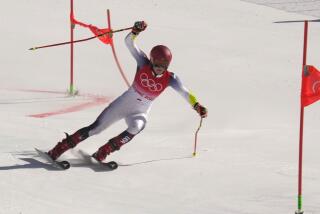A rare tie in women’s Olympic downhill doubles the golden glow
- Share via
SOCHI, Russia — The women’s Olympic downhill at Rosa Khutor did not end Wednesday with American Julia Mancuso winning her fifth Olympic medal and second of these Games.
It did not end with race favorite Maria Hoefl-Riesch of Germany winning her fourth gold medal in her seventh Olympic start.
The downhill ended in, of all things, a tie.
FRAMEWORK: Best images from Sochi
It seems difficult to believe that a sport that relies on precision timing provided by Omega could not settle the difference between two racers, covering 1.7 miles, down a mountain.
As they say, though, the clock doesn’t lie.
Switzerland’s Dominique Gisin and Slovenia’s Tina Maze crossed the finish line in 1 minute 41:57 seconds to produce the first gold medal tie in Olympic Alpine history.
Switzerland’s Lara Gut, one-tenth of a second off the pace, won the bronze.
Gisin and Maze didn’t seem to mind sharing as they hopped on the top platform in flower ceremonies after Wednesday’s race.
“It’s incredible,” Maze said. “Maybe just one finger, maybe just one hand, can change the color of the medal.”
Ties are unusual, but not unprecedented, in ski racing. There had been four previous Olympic Alpine ties, the last in 1998.
In 1992, America’s Diann Roffe-Steinrotter tied Austria’s Anita Wachter for the giant slalom silver.
Mancuso and Hoefl-Riesch, expected to contend for Wednesday’s gold, were both off their games.
Mancuso won the combined downhill portion on her way to bronze on Monday, but Wednesday she could only manage eighth.
Mancuso said she got tentative after catching too much air on an early jump and never regained her race rhythm.
She finished .99 out of first and .89 out of a medal.
“Just thinking too much kind of kicked me out of my game,” Mancuso said. “I felt like I wanted to hit the reset button.”
Mancuso was the top American finisher, followed by Laurenne Ross (11), Stacey Cook (17) and Jackie Wiles (26).
Hoefl-Riesch, who won Monday’s super combined, finished 13th.
“It was just a bad run for me,” she said.
Hoefl-Riesch still has medal chances in super-G, giant slalom and slalom.
The viewing world may have been shocked by Wednesday’s tie, but Gisin and Maze were not.
The first World Cup victory for each racer also ended in a dead heat. In fact, Maze’s win, a giant slalom in 2002, was the first three-way tie in World Cup history.
Gisin’s first win was a 2009 downhill in which she tied with Sweden’s great Anja Paerson.
“I shared my first World Cup with Anja,” the 29-year-old Gisin said, “I’m sure glad I’m going to share my gold with Tina.”
The tie was special for different reasons.
Maze’s gold provided affirmation for a career in which she won two silver medals in Vancouver and the World Cup overall title in 2013.
“I came to the Olympics to win a gold and I achieved my goal,” the 30-year-old Slovenian said.
Gisin’s gold was the payoff for persistence in a career in which she has endured nine knee surgeries and a multitude of other injuries.
At the Olympic downhill four years ago, Gisin made news when she crashed on the final jump at Whistler and cartwheeled down the hill into the finish corral.
Both downhill runs, for her, ended in tears.
“Four years ago I cried as well,” Gisin said, “but in a different way.”
Twitter: @dufresnelatimes
More to Read
Go beyond the scoreboard
Get the latest on L.A.'s teams in the daily Sports Report newsletter.
You may occasionally receive promotional content from the Los Angeles Times.







